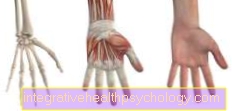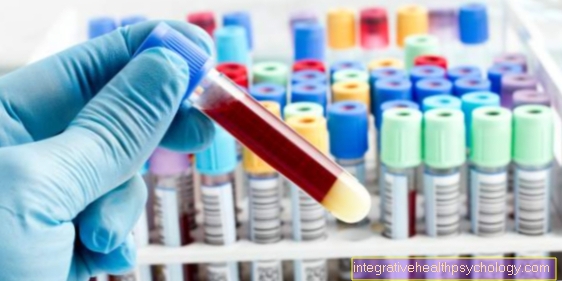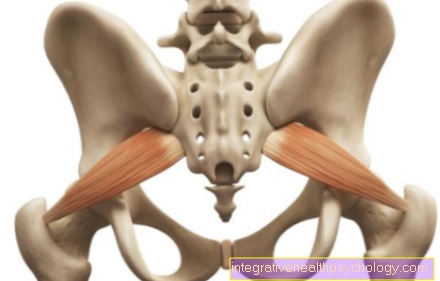Symptoms of an underactive thyroid
definition
The hypothyroidism shows a deficiency in the thyroid hormones thyroxine (T4) or Triiodothyronine (T3). This deficiency leads to a slowdown in the metabolism with a drop in performance and fatigue. Medically, the underactive thyroid, or the lack of thyroid hormones, is referred to as hypothyroidism. There are many causes of hypothyroidism, typical are autoimmune diseases in young women, which are associated with a breakdown of thyroid tissue (e.g. Hashimoto's thyroiditis).

Hypothyroidism symptoms
Depending on whether the body can still compensate for the hormone deficiency or how many hormones are missing, the clinical picture and thus the symptoms of an underactive thyroid fluctuates.
Symptoms of acquired hypothyroidism:
The symptoms of acquired hypothyroidism usually develop slowly:
- decreased performance, both physically and mentally
- Lack of drive
- persistent fatigue
- Slowdown
- Loss of appetite
- Depression and disinterest
- Sensitivity to cold
- Weight gain
- Constipation
This can all be explained by the reduced metabolism.
The following also occur:
- dry, flaky skin
- brittle hair
- hoarse voice
- decreased heart rate (Bradycardia)
- enlarged heart
- Menstrual cycle disorders in women
- Erection problems in men
- infertility
Symptoms of congenital hypothyroidism:
At birth there are no symptoms of an underactive thyroid at first, as the child is still supplied with hormones from the mother's blood. With the breakdown of maternal hormones, symptoms such as an enlarged tongue, laziness to drink, constipation and prolonged neonatal jaundice become apparent. The children are very sleepy and have slack muscles. If the disease is not recognized, further symptoms in the form of reduced body size and low intelligence will occur. The children develop speech disorders, muscle weakness, attention deficit and increased cross-eyes.
Digestive tract symptoms
Weight gain
In many patients with pronounced hypothyroidism (Hypothyroidism) without a change in eating habits, there is continuous weight gain. This is due to the fact that the reduced concentration of thyroid hormones (T3 / T4) in the blood results in a reduced energy turnover in the human body.
The thyroid hormones influence the oxygen consumption in the cells and regulate various metabolic processes. As a result of the lowered levels of thyroid hormones in the blood, the various metabolic pathways are slowed down and fewer carbohydrates and fats are broken down. The additional food components that arise with normal eating habits are therefore not broken down and accumulate in the tissue. In addition, the blood lipid levels (especially cholesterol) can rise.
The weight gain varies from patient to patient. It depends, among other things, on the respective eating habits and sporting activities. Younger patients in particular tend to have more severe symptoms. Often, weight gain is not attributed to an underactive thyroid. Even at the beginning of therapy, the weight can initially increase slightly until the individual correct dosage is found.
Read more about the topic here: Lose weight with an underactive thyroid
nausea
An underactive thyroid leads to a sluggish gastrointestinal tract, among other things. Therefore, nausea can also occur in this context.
The nausea can be more or less pronounced and is usually not related to food intake. So the nausea also occurs between meals. It is often associated with constipation and bloating, and in severe cases it is accompanied by vomiting. In some patients this nausea occurs in combination with dizziness.
Most of the time, nausea is not in the foreground with an underactive thyroid, but it can also create a significant level of suffering.
Read more about the topic here: Dizziness and Thyroid - What Are the Relationships?
Diarrhea and constipation
The occurrence of diarrhea in the context of an underactive thyroid is rather rare. Typically, severe diarrhea occurs when the thyroid gland is overactive. On the contrary, an underactive thyroid often leads to severe constipation (constipation). Accompanying this, patients can sometimes experience severe flatulence, abdominal pain and nausea. Occasionally, patients report that the severe constipation alternates with brief diarrhea (so-called. more paradoxical Diarrhea)
For information on clogging, see Constipation - What Can You Do About It?
Other internal symptoms
Heart rate
In the context of an underactive thyroid (Hypothyroidism) the reduced energy expenditure and a direct inhibition of cardiac activity usually lead to a decrease in heart rate (so-called bradycardia). A racing heart, on the other hand, is more likely to be observed with an overactive thyroid.
Due to the decreased heartbeat, there is a risk of hypothyroidism that the blood will back up in front of the heart and the symptoms of heart failure occur. Overall, the heart appears enlarged. In addition, patients with an underactive thyroid often have low blood pressure.
Please also read our article on this Consequences of cardiac arrhythmias.
Tremble
Increased tremors occur especially when the thyroid gland is overactive (hyperthyroidism). In addition, the patients are characterized by psychomotor restlessness and increased irritability. The shaking (tremor) typically increases when grasping or when the hand approaches a target. An occurrence with an underactive thyroid is rather untypical and only occurs in very rare cases.
tingle
Another rare symptom of an underactive thyroid is a tingling sensation on the surface of the skin, which those affected often find uncomfortable. This occurs more frequently in the arms and legs. Many patients also report an increase in symptoms during the night. Sometimes the tingling alternates with a feeling of numbness in the affected skin area. In addition to the tingling sensation, other abnormal sensations are possible.
Hypoglycaemia
As numerous studies in recent years have shown, there is a connection between an underactive thyroid and diabetes (diabetes mellitus). According to this, there was a significantly increased tendency to hypoglycaemia in patients with hypothyroidism. This is due to the fact that the thyroid hormones (T3 / T4) are responsible, among other things, for releasing sugar from storage supplies via various metabolic pathways. A lack of thyroid hormones therefore leads to a reduced concentration of glucose in the blood and at the same time increases the risk of hypoglycaemia. A therapeutic normalization of the thyroid function is therefore urgently required in diabetes patients.
For more information on this topic, see Hypoglycaemia.
Water retention
Often, as part of an underactive thyroid, water is stored in the body. Disturbed metabolic processes pull the water out of the vessels and accumulate in the various tissues. The patients experience swelling (Edema) in characteristic places on the body. These manifest themselves primarily on the eyelids, hands and feet, as well as on the lips and tongue.
In rare cases, language changes due to swelling of the vocal cords. The patients stand out with a hoarse voice and slow and labored speech (see also: Swollen vocal cords). In addition, in very rare cases, involvement of the heart is possible. Swelling of the heart can cause serious complications.
You can find an overview of edema and its causes here: Causes of Edema
Decreased thirst
Patients with an underactive thyroid often report a significantly reduced thirst. As a result, the patient cannot keep the recommended amount of 2 liters per day.
The underactive thyroid causes water to be retained in the human body. As a result, swelling (edema) occurs primarily on the face, eyelids, arms and legs. Due to the accumulation of water in the body, the affected person has a reduced feeling of thirst.
Symptoms of the head and mind
a headache
The majority of patients with an underactive thyroid report headache as the disease progresses. In addition to the headache, patients often report increased fatigue, rapid exhaustion and a significant slowdown in everyday activities. In rare cases, a migraine caused by an underactive thyroid can occur. In addition, existing headaches can be made worse by a thyroid disease.
As individual study results have shown in recent years, chronic headaches can also inversely increase the risk of thyroid disease.
Visual disturbances
In rare cases, an underactive thyroid also involves the eyes. Hashimoto's thyroiditis is often the cause.
Visual disturbances can mainly occur due to a disturbance in the function of the eye muscles. Patients often report double vision initially. In addition, watery eyes, swollen eyelids or insufficient eyelid closure can lead to various visual disorders. In very rare cases, it can also damage the optic nerve, which severely affects vision.
Information on Hashimoto's thyroiditis do you think ...? Find here.
depression
The symptoms of underactive thyroid can in many cases be similar to those of depression. Typical of depression are decreased drive, listlessness and indolence. These symptoms can also be seen in untreated hypothyroidism. Therefore, if you suspect depression, it is important to check your thyroid levels at the beginning.
Clinically, depression can be distinguished from hypothyroidism by checking the presence of the other symptoms. Conversely, chronic hypothyroidism can in some cases encourage the development of true depression. Most of the time, however, the depressive symptoms disappear after treatment of the hypothyroidism is initiated.
Read more on the subject at: Symptoms of depression
Panic attacks
In rare cases, an underactive thyroid (hypothyroidism) also manifests itself through psychological symptoms. The patients are characterized by a pronounced anxiety. They are also very nervous and jumpy. In extreme cases, these patients experience panic attacks. The mental symptoms should not be misinterpreted as an expression of a mental disorder. As a rule, adjusting the thyroid hormone level leads to a significant improvement in the symptoms.
You can find detailed information about the clinical picture at Panic attack.
External appearances
Symptoms on the skin
In almost all cases, hypothyroidism causes symptoms on the skin:
- Swelling: The swelling of the skin that is caused by an underactive thyroid is called myxedema by doctors. This edema differs from water retention in that there are no dents left after being pressed in.
- cool and pale skin
- Cracks and dry, flaky spots
- reduced perspiration (Hypohidrosis)
eye bags
In rare cases, an underactive thyroid gland (hypothyroidism) also manifests itself in the patient's eyes. The cause is often an inflammatory disease of the thyroid gland, which leads to a reduced production of thyroid hormones, Hashimoto's thyroiditis. In addition, hyperthyroidism as part of an inflammation of the thyroid gland (Graves' disease) can lead to numerous symptoms in the eyes.
The majority of patients report a tendency to dark and sometimes very strong circles under the eyes. These do not only occur with increased fatigue but also in everyday life. In addition, the eyelids can also be puffy and pulled up. Patients often complain of watery eyes, a burning sensation in the eyes, increased sensitivity to light and a feeling of foreign bodies. In addition, the eyes often appear somewhat protruding from the eye socket (so-called. Exophthalmos) and therefore an eyelid closure is sometimes only possible to a limited extent. Disturbances in the eye muscles can also cause double vision and other visual disturbances in the patient.
Please also read our article on this Causes of dark circles.
Hair loss
Another common symptom of underactive thyroid gland (Hypothyroidism) represents hair loss. Thyroid diseases are one of the most common causes of hair loss in Germany. It must be taken into account that both hypothyroidism and hyperthyroidism can lead to hair loss.
While milder forms of hypothyroidism often only lead to brittle and very dry hair, more severe forms of hair loss (loss of significantly more than 100 hairs per day) also occur. The scalp also appears dry and rough. Other body hairs can also be affected by an underactive thyroid (e.g. eyebrows).
About every second patient with a manifest hypothyroidism is affected by hair loss. Hair loss often develops slowly and remains undetected for a long time.
Read more about the next articles here:
- Hair loss from the thyroid gland
- Hair loss from a thyroid disorder
Development of a goiter
An iodine deficiency can lead to an underactive thyroid. The body tries to compensate for the decreased production of thyroid hormones (T3 / T4) by stimulating the growth of the thyroid gland. As a result, the thyroid gland becomes increasingly enlarged, known as goiter (goiter). This can sometimes take on dimensions the size of a tennis ball and, in the event of a causal iodine deficiency, can be treated by substituting iodine. In rare cases, surgical removal of the goiter may be necessary.
Detailed information can be found here: Goiter (Goiter)
Symptoms in men
An underactive thyroid causes a number of typical symptoms in men. Depending on how pronounced the hypothyroidism is, the symptoms can also vary in men.
An underactive thyroid often passes through one first pronounced fatigue and poor performance on. This can also show up as listlessness. These symptoms in men express themselves e.g. due to reduced performance in sports, but also at work. The need for sleep also increases. It is not uncommon for fellow human beings to be more likely to notice these symptoms. The affected person appears unnaturally sluggish.
Further symptoms concern the perception of temperature. This is particularly noticeable in men Cold intolerance. This means that you are freezing more often and normally perceive pleasant temperatures as too cold. In addition, an underactive thyroid in men is often associated with one Weight gain. It should be noted that the weight gain is unwanted and cannot be explained by excessive consumption of food or a lack of exercise.
Next are symptoms of an underactive thyroid in men Changes in voice to call. This can be explained by a swelling of the vocal cords. There is a pronounced hoarseness. Other symptoms in men include a rough voice and possibly slow, slow speech. It also causes an underactive thyroid Symptoms on the skin. This will be cool and pale. Sometimes there are swellings on the shins.
In some cases, an underactive thyroid in men is primarily manifested by symptoms that affect sexuality. There will be a Loss of libido, that is, of sexual desire, and the power described. For example, some men with untreated hypothyroidism find it difficult to get an erection.
The extent to which the symptoms mentioned occur in men is variable. Not every hypothyroidism has to have all symptoms.
Symptoms in women
In women, too, hypothyroidism manifests itself through a number of characteristic symptoms. As with men, the underactive thyroid is made up of symptoms such as Fatigue, weakness and decreased drive noticeable. The incorrectly regulated temperature perception is more evident in women than in men. This Cold intolerance is very pronounced in women.
There is also one significant weight gain. In addition, symptoms of underactive thyroid, especially in women, affect the skin, hair and nails. It becomes doughy Swelling of the skin. The shins and eyelids are particularly affected. Other symptoms in women are one dry and brittle skinthat persists despite more creaming. The vocal cords are also occupied in a similar way to men, so that an unnaturally deep, rough voice can be observed.
Symptoms in Pregnancy
During pregnancy, there are various changes in metabolic processes. An underactive thyroid also leads to a number of different symptoms during pregnancy. On the one hand, there are general symptoms of hormone deficiency in the case of hypothyroidism during pregnancy. These include tiredness, disorders of the skin, hair and nails, as well as weight gain and a feeling of cold.
The symptoms of an underactive thyroid during pregnancy can be masked or increased by the other changes in the body. A pregnant woman gains weight even with a healthy thyroid. Water retention is aggravated by a simultaneous hypothyroidism during pregnancy. An underactive thyroid is of particular importance during pregnancy for the unborn child. This is supplied by the mother with thyroid hormones. If this is not possible, the baby can be seriously damaged. These include mental and physical developmental disorders. Therefore, thyroid control is extremely important during pregnancy.
Read more about this at: Hypothyroidism in pregnancy
Symptoms in the child
Untreated hypothyroidism in children can have extremely serious consequences, as thyroid hormones are essential for the child's physical and mental development. Congenital hypothyroidism is particularly dangerous here.
In the womb, the unborn child is supplied with thyroid hormones by the mother. This does not apply after the delivery. Immediately after birth, the babies stand out due to weakness, laziness to drink and indifference. If the hypothyroidism persists, further significant symptoms will develop over time. Failure to thrive, which manifests itself as short stature, can occur. A too large tongue is often noticeable in the child. In addition, general symptoms of an underactive thyroid such as constipation, brittle hair and nails, and doughy, dry skin can also be seen in the child. Reduced performance and lack of drive also speak for an underactive thyroid in the child.
Mental development is also impaired by a lack of thyroid hormones. Decreased intelligence, concentration and memory disorders can be symptoms. In the worst case, there is considerable mental retardation in the child. This is also known as cretinism.
If the underactive thyroid occurs relatively late in children, i.e. towards the teenage years, symptoms similar to those in adults are in the foreground. Physical and mental disorders mainly occur in early childhood in the development phase.
Diagnosis
The thyroid hormone levels in the blood are determined.
In the case of a latent (subclinical = without symptoms) Hypothyroidism are the free thyroid hormones T3 and T4 normal in the blood, but the brain's hormone that increases TSH.
In the case of a manifest (with symptoms) Hypothyroidism one differentiates, depending on the location of the cause. Is this in the thyroid itself, then the thyroid hormones are decreased, but the brain hormones are increased. If the cause is in the pituitary gland, both brain and thyroid hormones are low.
In the Autoimmune thyroiditis the antibodies can be detected in the blood.
In the congenital hypothyroidism the thyroglobin in the blood and iodine in the urine are also determined.
Further becomes a Ultrasonic made of the thyroid. In unclear cases, a scintigraphy may be useful.
Therapy of hypothyroidism
In the innate Hypothyroidism is the lifelong intake of Thyroid hormones (synthetic T4 = L-thyroxine) and blood level check-ups are necessary. The same applies to manifest hypothyroidism. Substitution therapy must be initiated slowly and slowly.The final dose depends individually on the patient's well-being and the values of the TSH. This should be in the normal range between 0.5 - 2.0 mU / l.
The latent hypofunction should also be treated with hormones in patients <70 years of age and if they wish to have children, as there is an increased risk of calcification of the vessels (=early atherosclerosis) consists.
complication
A complication can be a Myxedema coma occur, which is very rare today! This has a high lethality and requires intensive medical supervision. The breathing must be supported, the vital functions secured. Glucocorticoids and glucose are attached as infusions, the water and electrolyte balance must be monitored. Thyroxine is injected into the veins immediately. The body temperature is slowly normalized, usually hypothermia.
prophylaxis
There one Hypothyroidism by Iodine deficiency the iodine intake through food should be sufficient. The recommended amount of iodine for adults is 200µg / day. Pregnant women need about 300 µg / day. Foods that contain iodine are particularly Sea fish, salmon and iodized table salt.


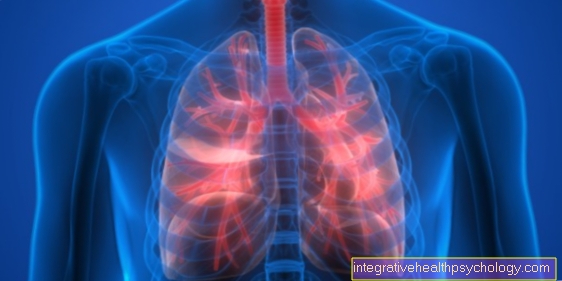





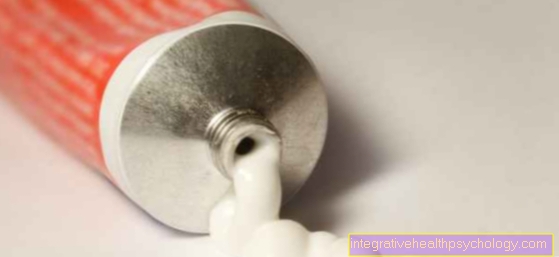

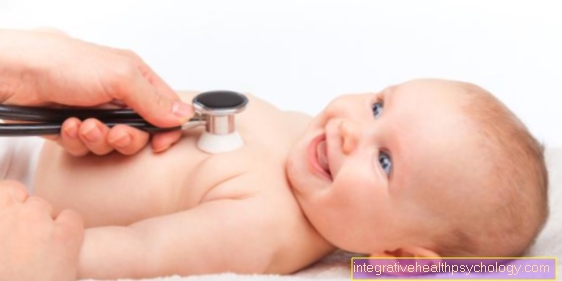

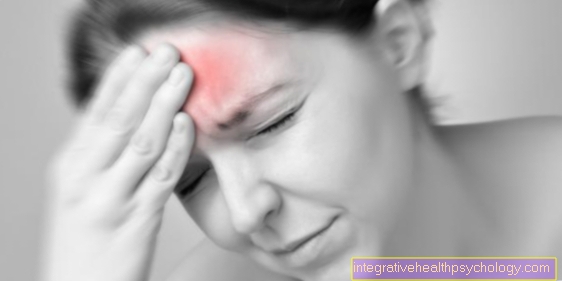
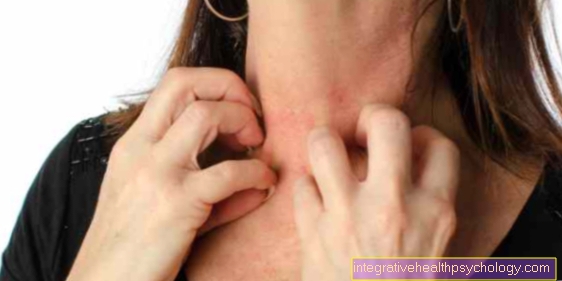



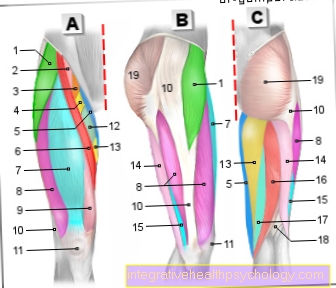


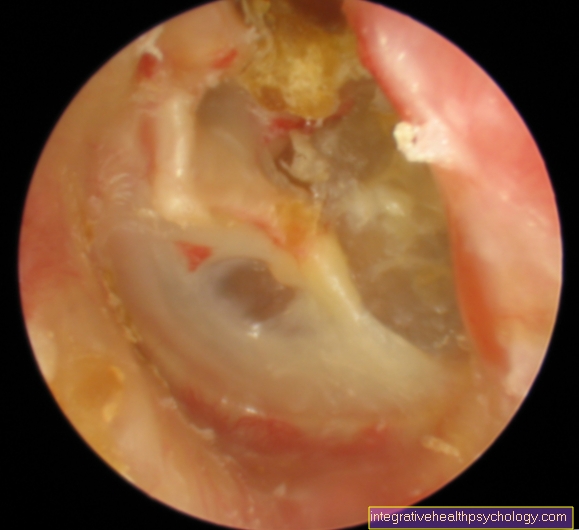

.jpg)

